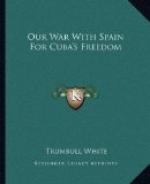Even Cuba, with all its abominations, scarcely afforded so remarkable a picture of Spanish oppression, miscalled government, as may be seen in the Philippines. It is only the remoteness and isolation of these unhappy islands that has prevented the atrocities there perpetrated from arousing the indignation of the whole world. Readers are familiar enough with the shocking barbarities practiced in times of disorder by the Spanish authorities, and they do not need to be multiplied here, but in the Philippines is demonstrated the utter incapacity of the Spanish for the exercise of civilized government over a dependent province even in times of so-called peace.
The Philippines are extremely interesting in themselves, but are seldom visited by tourists, partly in consequence of their lying out of the ordinary lines of travel and partly because of the policy of Chinese seclusion cultivated by the government. The climate, too, is unhealthy, even beyond what is usual in the tropics, and the unsettled state of the country, swarming with exasperated savages and bandits of the worst description, makes excursions beyond the limits of the principal cities very perilous. About 600 islands are included in the group, and the total area is considerable—some 150,000 square miles, three or four times that of Cuba, Exact data, however, are difficult to obtain. There are a multitude of insignificant islets hardly known except upon the charts of navigators; but Luzon almost equals Cuba in extent. Altogether the islands probably contain less than 8,000,000 souls; so that Spanish cruelty finds plenty of raw material to work upon.
Characteristics of the population.
And most of it is raw to the last degree—a medley of diverse and hostile races, ranging from the puny and dying remnant of the Negritos, who live like wild beasts in the highlands, subsisting upon the roots which they claw out of the ground, to the fierce and unsubdued Mohammedan tribes that still keep up the bloody war of creeds which raged in Spain itself for so many centuries. These latter are chiefly of Malay origin and many of them are professional head-hunters, well qualified to retort Spanish outrages in kind. There are also Chinese in large numbers and half-castes of all varieties. The proportion of Europeans is small, even in the cities. The resident Spaniards are all soldiers or officials of some sort and are there simply for what they can make by extortion and corrupt practices.
The Philippine islands were discovered in 1521 by Magellan, the circumnavigator, and were conquered by Spain and made a colony in the reign of Philip II., for whom they were named, half a century later. Spanish sway never has extended over more than half of the 1,400 islands of the archipelago, the others remaining under their native wild tribes and Mohammedan rulers. The conjectural area is about 120,000 square miles, and the estimated population about 7,500,000.




